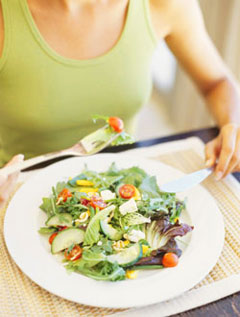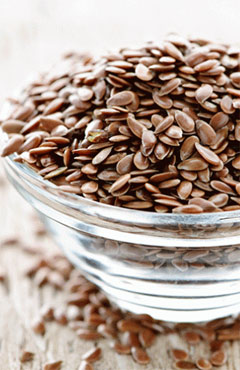 A
well-balanced, low-fat
diet with
plenty of fruits, vegetables, and whole grains is one of the best things you can
do for your overall health. Many experts are convinced that eating this way can
substantially reduce the amount of estrogen in
your body-and with it your risk of developing breast
cancer. A
well-balanced, low-fat
diet with
plenty of fruits, vegetables, and whole grains is one of the best things you can
do for your overall health. Many experts are convinced that eating this way can
substantially reduce the amount of estrogen in
your body-and with it your risk of developing breast
cancer.
You can make your eating habits breast friendly by trying these tips from the
experts.
 Go
easy on alcohol: Go
easy on alcohol:
In
a major study on the alcohol-breast cancer link, researchers concluded that a
woman who averages one drink a day over a lifetime could increase her breast
cancer risk by 30 to 40 percent. Up the ante to two drinks a day and her risk
could grow by almost 70 percent. Alcohol of any kind appears to increase the
amount of estrogen circulating in the body. Try to limit your alcohol intake to
just two or three drinks a week, advises JoAnn E. Manson, M.D., associate
professor of medicine at Harvard Medical School and co-director of womenís
health at Brigham and Womenís Hospital in Boston. (A drink is defined as 5
ounces of wine, 12 ounces of regular beer, or a mixed drink made with 11/2
ounces of 80-proof distilled spirits.)
 Aim
low Fat: Aim
low Fat:
Experts recommend that you
get no more than 20-25 percent of your calories from fat.
One study has found that this lower fat intake can help to relieve painful
breasts.
|
 Favor fiber. Favor fiber.
 Fiber should be part of
every womanís anti-breast cancer arsenal, according to nutrition researcher
Jean H. Hankin, R.D., Dr. P.H., of the etiology program of the Cancer
Research Center of Hawaii and professor of public health at the University
of Hawaii in Honolulu. Scientists believe that fiber may
reduce breast cancer risk by binding with excess estrogen and ushering it
out of the body before it has a chance to do harm. Fiber also appears to
interfere with the absorption of dietary fat, which, serves as a catalyst
for estrogen production. The National Cancer Institute recommends an intake
of 20 to 30 grams of fiber a day. You can hit the mark by eating lots of
whole grains, beans, fruits, and vegetables. Fiber should be part of
every womanís anti-breast cancer arsenal, according to nutrition researcher
Jean H. Hankin, R.D., Dr. P.H., of the etiology program of the Cancer
Research Center of Hawaii and professor of public health at the University
of Hawaii in Honolulu. Scientists believe that fiber may
reduce breast cancer risk by binding with excess estrogen and ushering it
out of the body before it has a chance to do harm. Fiber also appears to
interfere with the absorption of dietary fat, which, serves as a catalyst
for estrogen production. The National Cancer Institute recommends an intake
of 20 to 30 grams of fiber a day. You can hit the mark by eating lots of
whole grains, beans, fruits, and vegetables.
 Crunch
crucifers Crunch
crucifers
Time and again,
research has shown that women who eat lots of fruits and
vegetables are much less likely to develop breast cancer than women who
donít. Among the best cancer-fighters in the supermarket produce aisle are
the crucifers-broccoli, Brussels sprouts, cabbage, and cauliflower. These
veggies contain a number of compounds, called phytochemicals, that put the
squeeze on estrogen and prevent it from becoming destructive. To preserve
their phyto punch, eat crucifers raw. If you donít like them that way, then
cook them until theyíre just tender. Canadian researchers have found that
prolonged cooking can reduce the amount of at least one of the
cancer-combating compounds in crucifers by as much as 50 percent.
 Go
fishing. Go
fishing.
Fish such
as Atlantic herring, canned pink salmon, and Bluefin tuna are rich in omega-3
fatty acids. Laboratory evidence suggests that these fatty acids can stymie the
growth of cancerous breast tissue.
 Gobble
garlic. Gobble
garlic.
Researchers at Memorial
Sloan-Kettering Cancer Center in New York City have isolated four compounds
in garlic that appear to stop breast cells from becoming cancerous in
laboratory tests. These compounds also help to convert estrogen to a weaker
form that isnít as likely to instigate breast cancer.
 Savor
soy foods. Savor
soy foods.
Soy is a staple in
many Asian countries, and researchers believe that itís responsible for
keeping the breast cancer rates among Asian women so low. It contains
isoflavones, phytochemicals that mimic the hormone estrogen in the body
but are 100,000 times weaker than the real thing. The isoflavones occupy
places on breast cells called receptor sites, blocking estrogen from
doing so. The average Asian consumes 50 or more milligrams of soy
isoflavones daily. Research suggests that if you eat just one serving of
soy, that may be enough for you to experience some of its protective
effects. Try adding cooked soybeans to chili, stir-frying tofu in place
of meat for a variety of dishes, or drinking soy milk, which can be
found in health food stores and some grocery stores. Keep in mind,
however, that soy sauce and soybean oil donít contain isoflavones.
 Favor
Flaxseed. Favor
Flaxseed.
 Flaxseed contains
compounds called lignin precursors. Scientists have just begun investigation how these phytochemicals work. Early studies show that
lignin precursors change into a weak form of estrogen in the body and
then act pretty much like isoflavones. Try sprinkling two heaping
tablespoons (about 25 grams) of ground flaxseed on cereal or in juice if
you want to get the same amount that breast cancer researchers are
studying at the University of Toronto. Check your favorite health food
store or baking catalog to find flaxseed. Flaxseed contains
compounds called lignin precursors. Scientists have just begun investigation how these phytochemicals work. Early studies show that
lignin precursors change into a weak form of estrogen in the body and
then act pretty much like isoflavones. Try sprinkling two heaping
tablespoons (about 25 grams) of ground flaxseed on cereal or in juice if
you want to get the same amount that breast cancer researchers are
studying at the University of Toronto. Check your favorite health food
store or baking catalog to find flaxseed.
 Opt
for olive oil. Opt
for olive oil.
In a study
involving more than 2,000 Greek women, those who consumed olive oil at
least once a day were 25 percent less likely to develop breast cancer
than those who didnít. Scientists canít yet explain how the oil protects
against cancer, but they believe it has something to do with
antioxidants in the oil. (Antioxidants help to neutralize free
radicals.)
 Lean toward E. Lean toward E.
Vitamin E flexes its
cancer fighting muscle in several ways. First, itís an antioxidant,
which means it helps mop up those damaging free radicals and prevents
them from doing harm. Second, it keeps your immune system in good
working order. And third, it appears to thwart the formation of
cancer-causing compounds in your body. Vitamin E can be difficult to get
through foods. One of the best sources is wheat germ: A serving of 12/3
tablespoons contains four international units of E.
The dietary modification should include an emphasis on whole cereal grains
and also lifestyle changes, which include exercise and
spiritual clarity.
Dated 09 September 2013
|









